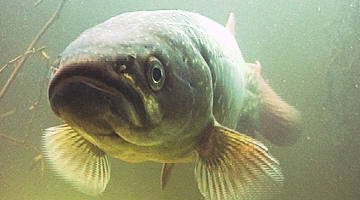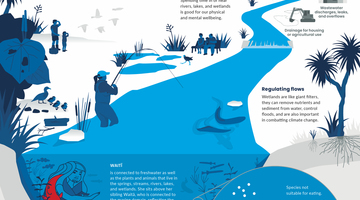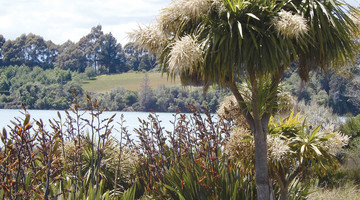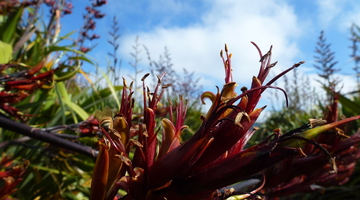Te ao Māori (the Māori world view) recognises the connections between all living and non-living things. In this video, kairangahau Māori share some of their repo connections with us.
Questions for discussion:
- Cheri and Rob talk about memories. What role do memories play in repo restoration?
- Yvonne and Shannon talk about repo as repositories or places to store things. What types of things (physical and non-physical) were stored in repo?
Transcript
Cheri van Schravendijk-Goodman
There is this thing within western science where we tend to reduce things into their parts. It’s not necessarily a bad thing – it allows you to hone your expertise in those areas without becoming overwhelmed by the whole. The challenge, though, is our species, especially our birds and our fish, don’t know boundaries like we have classified them as. So they don’t know that that’s a wetland delineation versus a terrestrial, which is land. Tuna, if it’s in a flood, it’s going to go across the paddock when it’s hungry. The thing for us is about making sure that all those parts are connected.
Robert McGowan
You’ve got to look at the environment not as a thing or a resource but as a living person. We talk about Papatūānuku being mother. Every culture talks about Mother Earth. The Earth is your mother, and she has cared for you right from the very beginning.
Cheri van Schravendijk-Goodman
Repo were places where practices were undertaken. I can’t speak for all hapū and iwi obviously, but those that we have worked with have shared with us the strong connection in terms of the way they used to interact with our valued fish species, especially tuna, but also our birds. It was part of the whole storyscape, the memoryscape of that area that we interacted with.
We are a mua/muri people, ao we are very much a past/future people. We don’t tend to look at ourselves in the present, because as soon as you do that, you become bound to 3 to 5-year programmes of action. If we always remind ourselves of where we’ve come from, then we can take those learnings forward into a future that we want for our next generations.
Robert McGowan
The memories tell us how it used to be and will actually help people to remember how these places were important to them and the stories there.
Yvonne Taura
Fully functioning, healthy repo are repositories for mātauranga. Everything here, our birds, our plants, our wai, everything in and above it tells us the story of why it was so important for our whānau, our tūpuna to engage with. These kept our whānau alive, these kept our tūpuna alive.
Shannon Te Huia
They were like our fridge. And this is just coming from uncles and kaumātua that it was a source where they’d go and get duck eggs, where they’d get tuna, birds – everything that would sustain our people.
Cheri van Schravendijk-Goodman
They were part of our medicine cabinet, so our rongoā were also found in there. They’re also really important spaces for sharing kōrero about who we are as people – so a chance to sit down and interact with each other and share information across generations about where we came from, what made us unique, what values were important to us and the way that we interacted with our environment. They were also really important spaces for harvesting non-animal or non-plant-like resources, like our paru, our kōkōwai, which we use for dyeing and other things. They had value for being spaces where we could store our taonga or protect our taonga.
Shannon Te Huia
The chemical make-up of the repo would preserve the wood and stuff, so it’s no surprise that carvings and stuff are found in wetlands.
Dr Beverly Clarkson
It was a huge learning curve to realise that Māori know a lot about wetlands, there’s a lot of traditional knowledge. And the mātauranga perspective enriched our understanding of wetlands, and it’s a way forward to look after all our wetlands in the future.
Shannon Te Huia
With your basket and my basket, we will reinvigorate our awa working together. Nā tō rourou, nā taku rourou, ka ora ai te awa.
Acknowledgements
Illustration of Papatūānuku embracing Ranginui, from the graphic novella Te Orokotimatanga o te Ao, story by Rewi Spraggon, and artwork by Munro Te Whata. Courtesy of Kiwa Digital. Downloads available on Appstore for Apple or Google Play for Android
Aataentsic (Huron Nation) living sculpture at Jacques-Cartier Park in Gatineau, Canada, by bobhilscher, 123RF Ltd
Hindu Goddess Durga fighting the buffalo-demon, attributed to Guler School (ca early 1700), Public Domain
Historical footage, woman harvesting kōura with a whakaweku, 1937, The Footage Company Australia/British Movietone
Historical still, gathering sea food, possibly in Paihia. Denton, Frank J, 1869–1963: Collection of negatives, prints and albums. Ref: 1/2-008468-G. Alexander Turnbull Library
Historical photo, women fishing for matamata on the Waikato River near Tuakau. James Cowan, The Maori: yesterday and to-day. Wellington: Whitcombe & Tombes, 1930. Sourced from Te Reo o Te Repo – The Voice of the Wetland
Close-up photo, Kawakawa leaves, Jon Sullivan, CC BY-NC 2.0
Photo, kawakawa tincture soaking, Jamie Watson
Footage of Eeling F80217 – [MĀORI EELING] [ 193-]. From material preserved and made available by Ngā Taonga Sound & Vision. Courtesy of Dave Turnbull
Photo of Uenuku, the Atua of the Rainbow, Ngā iwi o Tainui (The tribes of Tainui). Whakairo rediscovered in Lake Ngaroto (Estimated date: 1200-1500. Accession number 2056); Photograph of the Return of Uenuku to Te Awamutu Museum (Image date: 06 Oct 1987. Accession number: PH2514/4); and photo, Māori women standing around Uenuku after he was transferred back from old museum. (Image date: 18 Nov 1975. Accession number PH2102); all courtesy of Te Awamutu Museum Collection, and with permission from Ngā iwi o Tainui






